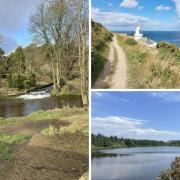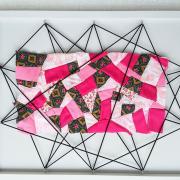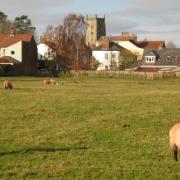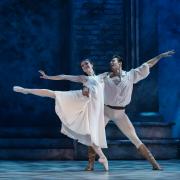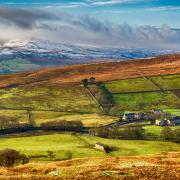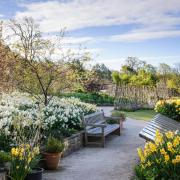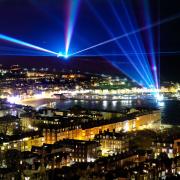Exhibition will tour internationally to Paris and New York after its London run ends on May 29th.

Most 80 year olds celebrate their birthday with a slice of cake (fire extinguisher at the ready) and a sing-song with their nearest and dearest. But not David Hockney.
The Bradford-born octogenarian (from July 9th at least) is marking his milestone birthday with the fastest-selling exhibition in the history of Tate Britain.
More than 20,000 tickets were sold before the exhibition opened on February 9th, and the queues continue to grow around the block in Millbank.
Tate Britain’s exhibition – simply called David Hockney – is the world’s most extensive retrospective of the work of West Yorkshire artist, widely regarded as one of the most successful and recognisable artists of our time. Organised to mark his landmark year, it will tour internationally to Paris and New York after its London run ends on May 29th.

Hockney has frequently changed his style and way of working over his long career, embracing new technologies along the way, something clearly acknowledged in this exhibition, which celebrates his achievements in painting, drawing, print, photography and video. It shows how the roots of each new direction can be traced directly back to the work before; how his radical assemblages of photographs in the 1980s informed the paintings of his Hollywood home, and his abstract works in the 1990s influenced his perception of the Yorkshire Wolds.
The exhibition is presented as a chronological overview – a visual biography visitors can follow from gallery to gallery – that traces Hockney’s development from his first forays on the public stage as a student in 1961, through his iconic works of the 1960s and 1970s and on to his recent success at the Royal Academy and beyond.
It shows how he has consistently questioned the nature of pictures and picture-making, using parody and self-reflection to challenge conventions. It also allows us to meet the people behind the man in a series of portraits of his family and friends, and the landscape that shaped him in his celebrated series of Yorkshire landscapes.
‘It’s been a pleasure to revisit works I made decades ago, including some of my earliest paintings, said David. ‘Many of them seem like old friends to me now.

‘We’re looking back over a lifetime with this exhibition, and I hope, like me, people will enjoy seeing how the roots of my new and recent work can be seen in the developments over the years.’
David Hockney (the exhibition, not the man) has been organised and curated by Tate Britain in collaboration with the Centre Pompidou in Paris and The Metropolitan Museum in New York, and is accompanied by a highly collectable and covetable catalogue and a programme of talks and events (see tate.org.uk for full details).
‘David Hockney is without doubt one of Britain’s greatest living artists,’ said Tate Britain director Alex Farquharson. ‘His practice is consistent in its pursuit of core concerns, while also wonderfully diverse.
‘His impact on post-war art, and culture generally, is inestimable, and this is a fantastic opportunity

to see the full trajectory of his career to date.’
And that’s yet another exciting point to consider, isn’t it? If this is an exhibition of Hockney’s career ‘to date’, that holds out the tantalising proposition that there are more innovations to come. He still paints every day and, if anything, has become even more prolific with age.
Hockney at 90? It’s a distinct possibility.
Broad brushstrokes
:: David Hockney was born in Bradford in 1937 and decided to pursue a career as an artist from a young age.
:: He joined Bradford School of Art in 1953, a move he found liberating: ‘It was thrilling to be at a school where I knew I would enjoy everything they asked me to do. I loved it all and used to spend 12 hours a day in the art school.’
:: He began studying at the Royal College of Art in London in 1959, when his contemporaries were artists Allen Jones, Peter Phillips and Patrick Caulfield.
:: Hockney visited California for the first time in 1964. The trip inspired his best-known work: a series of stylised landscapes and swimming pool paintings.
:: In the late Sixties and early Seventies, he embarked on a series of large double portraits, including one of dress designed Ossie Clark and fabric designer Celia Birtwell, who had just got married. The presentation of a seated man and standing woman broke with conventions of weddings portraiture, giving a realistic view of the subjects’ real lives.
:: Hockney painted his parents in 1971, a year before his father’s death. It shows his mother as a poised, graceful sitter, while his father is hunched over reading a book.
:: He began experimenting with photographic collages in 1982, joining dozens of Polaroid images, taken from varying angles, into one cohesive work.
:: In 2007, the Yorkshire-born artist returned home to produce Bigger Trees Near Warter. At 4.5 x 12 metres, it’s his largest work to date, created en plein (in the open air) on 50 separate canvases. ‘Trees are like faces,’ he said. ‘Every one is difference. Nature doesn’t repeat itself. You have to observe carefully; there is a randomness.’






